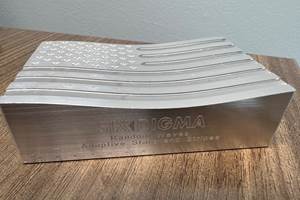How to Deal with Complexities That Affect Worker Skill Levels
The goal must be to keep tasks as simple as possible for those who perform them.
Share





My theme in recent months has been factors that contribute to your company’s corporate identity as well as how they affect your computer numerical control (CNC) environment. Here, we consider the impact that complexity has on your shopfloor personnel.
My rather broad definition of complexity includes anything that makes it more difficult to appropriately produce acceptable workpieces on CNC machine tools. In my opinion, there are two general factors that contribute to your company’s manufacturing complexity: the workpiece configuration/ design and the machining processes required to produce the workpiece.
Some workpieces and processes are obviously more complex than others. Determining an average throughout your company will provide a general view of this important factor. Regardless of this average, you still must be able to accommodate that company’s most complex workpiece configurations and manufacturing processes.
How do you assess your company’s complexity level?
Rate your company’s complexity level by analyzing workpiece configuration. From a manufacturing standpoint, obvious complexity-related attributes include a workpiece’s general size and shape, the required machining operations and production processes, tolerance specifications and how many pieces must be produced.
Manufacturing process must be appropriate to workpiece complexity. Additionally, you must look for ways to minimize the skill level required of the people performing the specific tasks related to manufacturing processes. For instance, manufacturing engineering personnel should enhance/simplify techniques used for making setups, running workpieces, inspecting completed parts and reporting results whenever possible.
Consider a company that has very small lots (possibly only one) of large, heavy, odd-shaped workpieces requiring multiple machining operations on different machine tools—including five-axis CNC machines—and having very small tolerances. If this is your norm, your focus must be on material handling, program-preparation systems and quality control, among other concerns. The goal must be to keep things as simple, or at least as feasible, as possible for the people involved.
On the other hand, if your company machines larger lots of workpieces that are smaller and simpler, easier to handle and have larger tolerances, your complexity-related challenges will be much different and probably simpler. But the goal must remain the same: to simplify required tasks for those who perform them on the shop floor.
Your company’s complexity level has an impact on everyone. The higher the complexity level, the more skill and knowledge is required of the people involved, starting with the design engineers and ending with those in your shipping department.
Manufacturing engineering personnel can do a great deal to help, assuming they have the skills to deal with workpiece-design complexities. They must act as a buffer between design engineers and shopfloor employees, translating complicated design-engineering concepts into shopfloor documentation and methods that hopefully can be easy to follow.
This concept is critical. The better engineered the manufacturing process, the simpler the tasks will be that must be performed. In turn, the simpler the related tasks, the lower the skill levels that will be required of the people performing them.
Even process-engineering efforts have their limits. Shopfloor personnel must possess the skills to do their jobs. Either they must already have these skills when you hire them, which is unlikely even with the simplest complexity levels, or more likely, you must provide targeted training to bring them to a level that allows them to be proficient performing the required tasks.
Related Content
Building Machines and Apprenticeships In-House: 5-Axis Live
Universal machines were the main draw of Grob’s 5-Axis Live — though the company’s apprenticeship and support proved equally impressive.
Read MoreThe Power of Practical Demonstrations and Projects
Practical work has served Bridgerland Technical College both in preparing its current students for manufacturing jobs and in appealing to new generations of potential machinists.
Read MoreHow I Made It: Nushrat Ahmed: CNC Swiss Operator
By day, 21-year-old Nushrat Ahmed is a CNC Swiss operator making automotive parts. By night, she handcrafts crocheted items.
Read MoreAddressing the Manufacturing Labor Shortage Needs to Start Here
Student-run businesses focused on technical training for the trades are taking root across the U.S. Can we — should we — leverage their regional successes into a nationwide platform?
Read MoreRead Next
Machine Shop MBA
Making Chips and 91ÊÓƵÍøÕ¾ÎÛ are teaming up for a new podcast series called Machine Shop MBA—designed to help manufacturers measure their success against the industry’s best. Through the lens of the Top Shops benchmarking program, the series explores the KPIs that set high-performing shops apart, from machine utilization and first-pass yield to employee engagement and revenue per employee.
Read MoreLast Chance! 2025 Top Shops Benchmarking Survey Still Open Through April 30
Don’t miss out! 91ÊÓƵÍøÕ¾ÎÛ's Top Shops Benchmarking Survey is still open — but not for long. This is your last chance to a receive free, customized benchmarking report that includes actionable feedback across several shopfloor and business metrics.
Read MoreAMRs Are Moving Into Manufacturing: 4 Considerations for Implementation
AMRs can provide a flexible, easy-to-use automation platform so long as manufacturers choose a suitable task and prepare their facilities.
Read More.jpg;width=70;height=70;mode=crop)






















